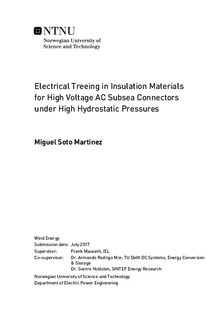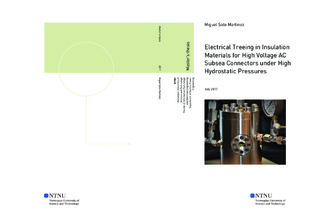| dc.description.abstract | To enable the next generation subsea boosting and processing facilities, high power electrical connectors are strongly needed and considered one of the most critical components of the system.
Electrical tree growth is a precursor to electrical breakdown in high voltage insulation materials. Therefore, the study of the tree growth dependency with hydrostatic pressure is needed to understand the behaviour of the insulation material used in subsea connectors. Silicone rubber (SiR) is used as an insulation material for these applications thanks to its higher viscosity characteristic in comparison with other solid insulation materials used in subsea cables. This property is the main factor that allows the water to be swiped off the connector when a receptacle is mated into the plug of a subsea connector. In addition, the silicone rubber must provide similar electric field control as other insulation materials used in cable terminations and connectors.
The characteristics of partial discharges generated during the electrical tree growth and the light emission from the partial discharge pulses, have been studied under different pressure conditions. SiR samples, with a needle to plate electrode configuration, have been put into a pressure vessel to grow the electrical tree in the material under high hydrostatic pressure conditions. The electrical tree growth has been divided in three stages (initiation, intermediate and final or prebreakdown stage) and tests have been performed at 1, 20 and 60 bar. A digital NIKON camera and a CCD camera have been used, both attached to a long-distance microscope, to observe in real time the tree growth and light emission, respectively.
Pictures showed a higher growth speed for the electric tree as voltage and pressure were increased. The length of electrical trees pre-grown at lower pressures collapsed faster as the pressure increased, than those pre-grown at higher pressures under the same pressure increasing conditions. As the pressure increased, Pulse Sequence Analysis performed to the partial discharges measured confirmed the partial discharge inception and extinction voltage increase and showed a polarity dependency to space charge generation in addition to other patterns regarding the charge magnitude and phase of occurrence characteristics. Pressure vessel internal reflections have suggested changes to be done in future studies for the light emission measurement. Finally, partial discharge patterns from the electrical tree growth process have been identified to be characteristics from void faults in the dielectric with a spherical void shape. | |

